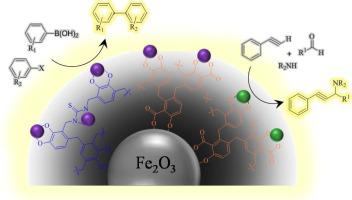Molecular Catalysis ( IF 3.9 ) Pub Date : 2020-07-07 , DOI: 10.1016/j.mcat.2020.111042 Somayeh Ostovar , Alireza Rezvani , Rafael Luque , Carolina Carrillo-Carrión

|
Magnetic core-shell Fe2O3@polymer-Pd/Cu nanocomposites (NCs) were developed as efficient and sustainable nanocatalysts for cross-coupling reactions. The designed NCs consisted of three components: i) a magnetic core (Fe2O3 nanoparticle), which allowed the recovery and reuse of the NCs, enhancing thus their attractiveness as green catalysts; ii) a catechol-based polymer coating, chosen because of its strong chelating ability towards metal ions, and its potential to be obtained from biomass (lignin depolymerization); and iii) catalytically active metal nanoparticles (Pd and Cu NPs) immobilized via in situ formation onto the polymeric shell. As-prepared Pd-based NCs successfully catalyzed Suzuki-Miyaura cross-coupling reactions, achieving yields between 87% and 97% in only 20–40 min depending on the aryl halides and boronic acid derivatives. Similarly, Cu-based NCs exhibited a quite good catalytic efficiency (> 80%) in the synthesis of propargylamines via A3 coupling reaction of phenylacetylene with various aldehydes and amines. Importantly, these NCs presented a good reusability, without significant decrease in efficiency after several cycles. However, the major advantage of the designed NCs is the lower Pd or Cu content (1.5 wt% and 2.6 wt%, respectively) as compared to most of the reported similar catalysts (between 3 – 6 wt% for Pd and > 5 wt% for Cu), which is a key challenge in view of developing cost-effective and environment-friendly catalysts while maintaining a high efficiency.
中文翻译:

核-壳型氧化铁@ cathecol-polymer @钯/铜纳米复合材料是交叉偶联反应中有效和可持续的催化剂
磁性核-壳Fe 2 O 3 @聚合物-Pd / Cu纳米复合材料(NCs)被开发为交叉偶联反应的有效和可持续的纳米催化剂。设计的NCs包含三个成分:i)磁芯(Fe 2 O 3纳米颗粒),可以回收和再利用NCs,从而增强其作为绿色催化剂的吸引力;ii)选择一种基于邻苯二酚的聚合物涂层,因为它对金属离子具有很强的螯合能力,并且具有从生物质中获得的潜力(木质素解聚);iii)通过原位固定的催化活性金属纳米颗粒(Pd和Cu NPs)形成到聚合物壳上。制备好的基于Pd的NCs成功催化了Suzuki-Miyaura交叉偶联反应,仅20到40分钟即可达到87%至97%的产率,具体取决于芳基卤化物和硼酸衍生物。类似地,铜基NC在通过A 3合成炔丙基胺中表现出相当好的催化效率(> 80%)。苯乙炔与各种醛和胺的偶联反应。重要的是,这些NC具有良好的可重用性,在几个循环后效率没有显着降低。但是,与大多数已报道的类似催化剂相比,设计的NCs的主要优点是Pd或Cu含量较低(分别为1.5 wt%和2.6 wt%)(Pd介于3 – 6 wt%和> 5 wt%对于铜),这是一个关键挑战,因为要开发具有成本效益和环境友好的催化剂,同时保持高效率。







































 京公网安备 11010802027423号
京公网安备 11010802027423号